OTD 355 Exam One Questions with
Correct Answers
ED/ER:
- OT role
- treatment - Answer-- OT role to assess end educate for discharge home
- 1-time visit
ICU:
- OT role
- treatment intensity
- length of stay - Answer-- evaluate and provide intervention that supports body systems
and prevents secondary impairments, promote early and simple ADLs, psychosocial
support, educate
- 1-2x/week if intubated and severe, 3-5x/week if higher level
- LOS varies
acute care:
- OT role
- treatment intensity
- length of stay - Answer-- evaluate and promote ADLs, engage in discharge planning,
provide psychosocial support, educate
- 1-7 days/week for 14-45 minutes
- 3-5 days
subacute care or LTAC:
- OT role
- length of stay - Answer-evaluate, continue to promote ADL, functional mobility,
psychosocial abilities, establish maintenance plan, educate
- LOS varies
inpatient rehab:
- OT role
- treatment intensity
- length of stay - Answer-- continued evaluation, intervention for all areas of occupation,
psychosocial support, and education and caregiver training
- 3-4 hours/day, 1-2 times/day, 5-7 days/week
,- 2-3 weeks
SNF:
- OT role
- treatment intensity
- length of stay - Answer-- continued evaluation, intervention for all areas of occupation,
psychosocial support, education and caregiver training
- 45 mins/day, 5-6 days/week
- 2 weeks- 3 months
LTC:
- OT role
- length of stay - Answer-- typically return to prior level of function (PLOF)
- 1 year - 2.5 years
outpatient:
- OT role
- treatment intensity
- length of stay - Answer-- higher-level functional needs
- 30-60 minutes, 2-3 days/week
- 4-12 weeks based on severity and goals
home health:
- OT role
- treatment intensity
- length of stay - Answer-- continued evaluation focused on basic ADLs, psychosocial
support, education and caregiver training
- 30-60 minutes, 2-3 days/week
- 2-4 weeks
hospice:
- OT role - Answer-- varies (psychosocial support, ADL support, pain management,
caregiver support)
client's objective comments that should be relevant to the treatment session - Answer-
subjective part of SOAP note
- player interview
,records of the session/ client's performance, data, acts, observations - Answer-objective
part of SOAP note
- commentator play-by-play
explain the data (including progress), draw conclusions (potential), problem list -
Answer-assessment part of SOAP note
- half-time assessments
how you will help the client achieve the goals - Answer-plan part of SOAP note
- post game coach interview
what should the objective portion of the SOAP note start with? - Answer-statement
about the setting and purpose/focus of session: who, what, when, where, why
- the client participated in a 30-minute OT session in the outpatient clinic for education
and hands-on instruction with ADL techniques to increase independence with UE
dressing
what is the heart of the SOAP note and what should it discuss? - Answer-assessment
- should discuss problems, progress, and potential
problem statements belong in what section of the SOAP note? - Answer-assessment
what are problems in the assessment part of SOAP note? - Answer-safety risks,
inconsistencies, contributing factors that show a need for intervention
- problem statements
what is the formula for problem statements? - Answer-the client requires (performance
level) to (functional activity) due to (deficit)
- deficits on tables 7 & 9 of OTPF
what is progress in the assessment portion of the SOAP note? - Answer-progress that
you noted within the session or compared to previous sessions
what is potential in the assessment portion of the SOAP note? - Answer-how does the
progress shown to affect the client's potential for improving
how should you wrap up the assessment section of the SOAP note? - Answer-expert
recommendation
, - client would benefit from continued instruction in and practice with UB dressing to
increase safety with ADL tasks
what should the plan include? - Answer-should contain frequency and duration and
purpose for continuation of intervention
- informs of priorities for intervention
what 3 things should documentation focus on? - Answer-1. function
2. progress (explain expectations for progress or explain slow progress)
3. safety
- summarize services needing focusing on skilled nature of service
Client moved kitchen items from counter to cabinet independently using L hand
- what part of SOAP note? - Answer-objective
Decreased coordination, strength, sensation, and proprioception in L hand create safety
risks in home management tasks
- what part of SOAP note? - Answer-assessment
increase of 15 minutes in activity tolerance for UE activities permits client to prepare a
light meal independently
- what part of SOAP note? - Answer-assessment
child participated in 60-minute evaluation of hand function in the OT clinic
- what part of SOAP note? - Answer-objective
continue retrograde massage to R hand for edema control
- what part of SOAP note? - Answer-plan
correct identification of inappropriate positioning 100% of time indicates memory WFL
- what part of SOAP note? - Answer-assessment
client reports that she cannot remember hip precautions
- what part of SOAP note? - Answer-subjective




